Digital Logic Circuits: Unit II: Combinational Circuits
Karnaugh Map (K-map) Representation and Minimization using K-maps
• In the previous section we have seen that for simplification of Boolean expressions by Boolean algebra we need better understanding of Boolean laws, rules and theorems.
Karnaugh Map (K-map) Representation and Minimization using
K-maps
•
In the previous section we have seen that for simplification of Boolean
expressions by Boolean algebra we need better understanding of Boolean laws,
rules and theorems. During the process of simplification we have to predict
each successive step. For these reasons, we can never be absolutely certain
that an expression simplified by Boolean algebra alone is the simplest possible
expression. On the other hand, the map method gives us a systematic approach
for simplifying a Boolean expression. The map method, first proposed by Veitch
and modified by Karnaugh, hence it is known as the Veitch diagram or the
Karnaugh map.
1. One-Variable, Two-Variable, Three-Variable and Four-Variable Maps
•
The basis of this method is a graphical chart known as Karnaugh map (K-map). It
contains boxes called cells. Each of the cell represents one of the 2n
possible products that can be formed from n variables. Thus, a 2-variable map
contains 22 = 4 cells, a 3-variable map contains 23 = 8
cells and so forth. Fig. 3.3.1 shows outlines of 1, 2, 3 and 4-variable maps.

•
Product terms are assigned to the cells of a Karnaugh map by labeling each row
and each column of the map with a variable, with its complement, or with a
combination of variables and complements. The product term corresponding to a
given cell is then the product of all variable in the row and column where the
cell is located. Fig. 3.3.2 shows the way to label the rows and columns of a 1,
2, 3 and 4-variable maps and the product terms corresponding to each cell.
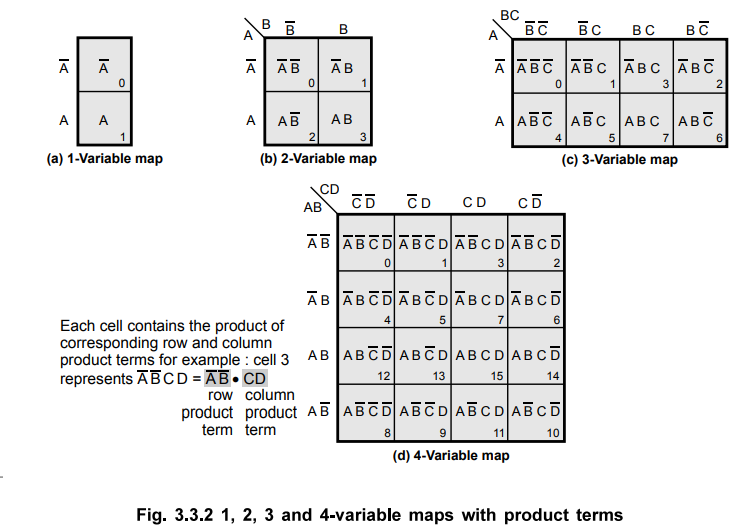
•
It is important to note that when we move from one cell to the next along any
row or from one cell to the next along any column, one and only one variable in
the product term changes (to a complemented or to an uncomplemented form). For
example, in Fig. 3.3.2 (b) the only change that occurs in moving along the
bottom row from ![]() to AB is the
change from
to AB is the
change from ![]() to B. Similarly, the only change that occurs in moving
down the right column from AB to AB is the change from
to B. Similarly, the only change that occurs in moving
down the right column from AB to AB is the change from ![]() to A. Irrespective of
number of variables the labels along each row and column must conform to the
single-change rule. We know that the gray code has same properties (only one
variable change when we proceed to next number or previous number) hence gray
code is used to label the rows and columns of K-map as shown in Fig. 3.3.3.
to A. Irrespective of
number of variables the labels along each row and column must conform to the
single-change rule. We know that the gray code has same properties (only one
variable change when we proceed to next number or previous number) hence gray
code is used to label the rows and columns of K-map as shown in Fig. 3.3.3.
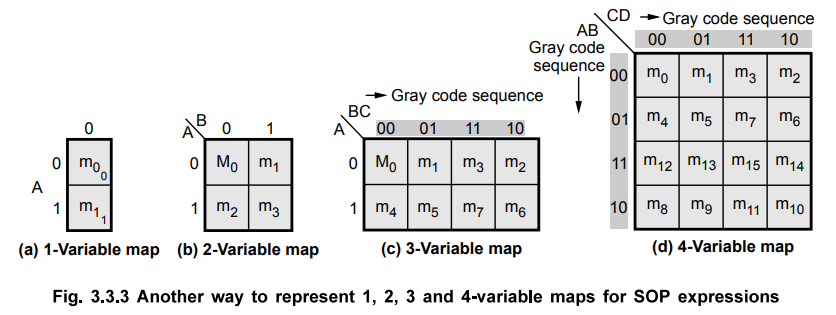
• The Fig. 3.3.3 shows label of the rows and columns of a 1, 2, 3 and 4-variable maps using gray code and the product terms corresponding to each cell. Here, instead of writing actual product terms, corresponding shorthand minterm notations are written in the cell and row and columns are marked with gray code instead of variables.
•
In case of POS expressions we assign maxterms (sum terms) to the cells of a
Karnaugh map. The Fig. 3.3.4 shows the way to label the rows and columns of a
1, 2, 3 and 4-variable maps and the sum terms corresponding to each cell. The
Fig. 3.3.4 shows label of the rows and columns of 1, 2, 3 and 4-variable maps
using gray code and the stun terms corresponding to each cell. Here, instead of
writing actual sum terms, corresponding shorthand maxterm notations are written
in the cell and row and columns are marked with gray code instead of variables.
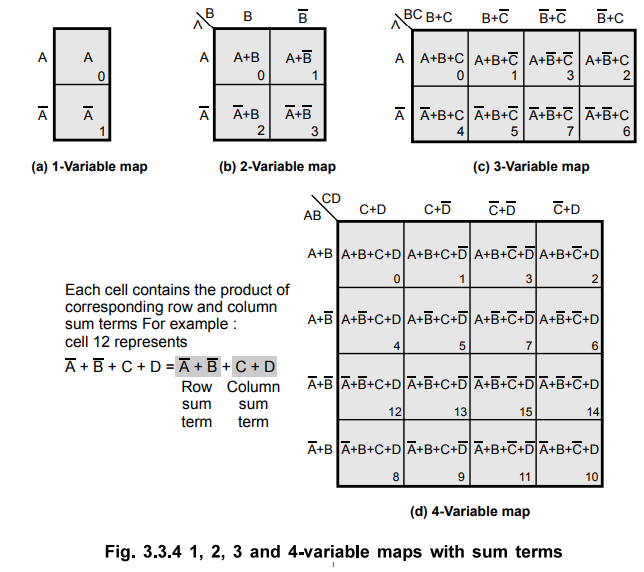
2. Plotting a Karnaugh
•
We know that logic function can be represented in various forms such as truth
table, SOP Boolean expression and POS Boolean expression. In this section we
will see the procedures to plot the given logic function in any form on the
Karnaugh map.
a.
Representation of Truth Table on Karnaugh Map
Cell
:
The smallest unit of a Karnaugh map, corresponding to one line of a truth
table. The input variables are the cell's co-ordinates and the output variable
is the cell's contents.
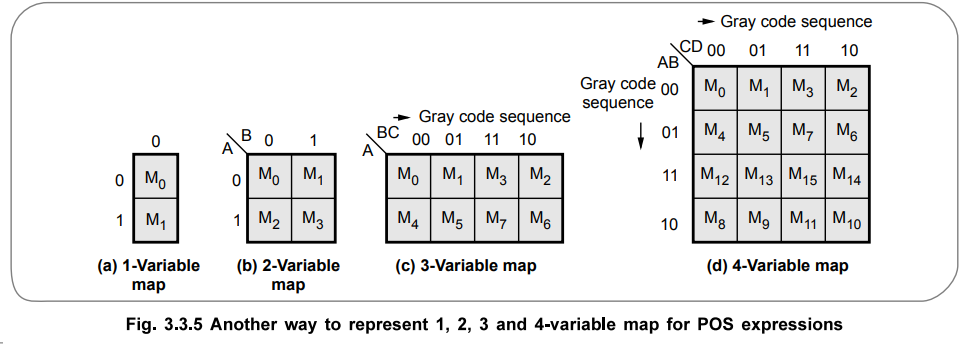
•
Fig. 3.3.6 shows K-maps plotted from truth tables with 2, 3 and 4-variables.
Looking at the Fig. 3.3.6 we can easily notice that the terms which are having
output 1, have the corresponding cells marked with Is. The other cells are
marked with zeros.

Note
The student can verify the data in each cell by checking the data in the
column Y for particular row number and the data in the same cell number in the
K-map.
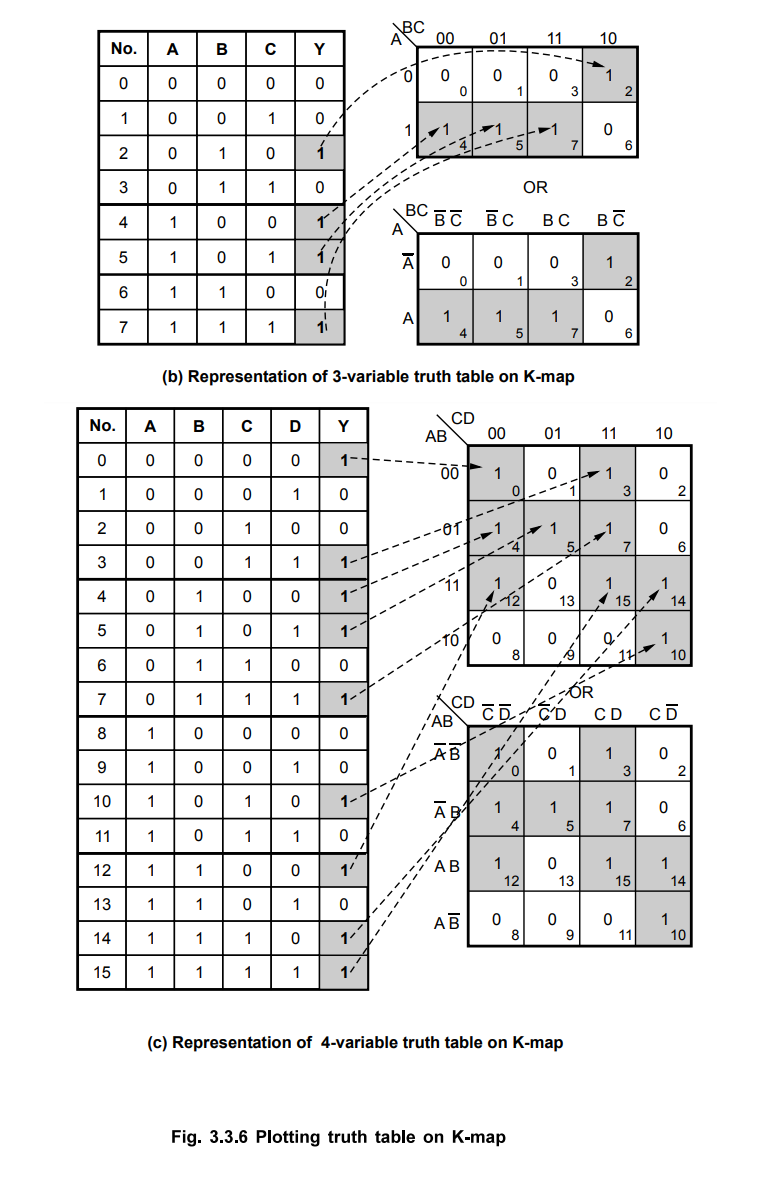
b.
Representing Standard SOP on K-Map
A
Boolean expression in the sum of products form can be plotted on the Karnaugh
map by placing a 1 in each cell corresponding to a term (minterm) in the sum of
products expression. Remaining cells are filled with zeros. This is illustrated
in the following examples.
Examples
for Understanding
Ex.
3.3.1 Plot Boolean expression  on the Karnaugh map.
on the Karnaugh map.
Sol.
:
The expression has 3-variables and hence it can be plotted using 3-variable as
in Fig. 3.3.7.
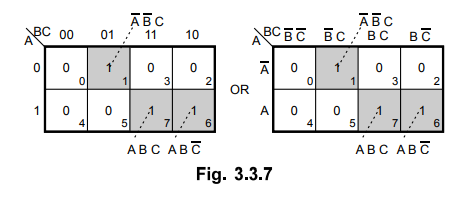
Ex.
3.3.2 plot Boolean expression

Sol.
:
The expression has 4-variables and hence it can be plotted using 4-variable map
as shown in Fig. 3.3.8.
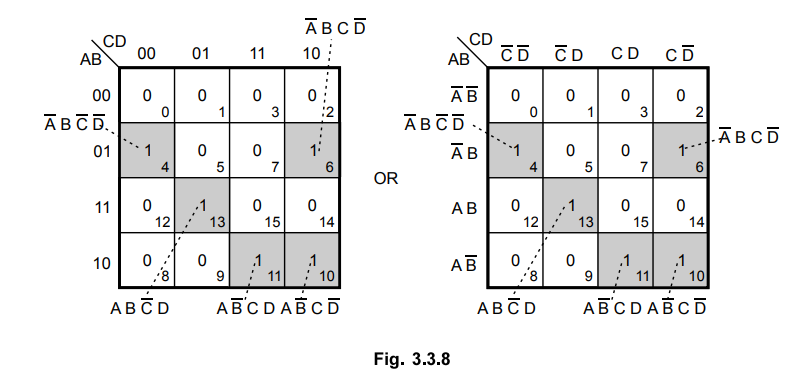
c.
Representing Standard POS on K-Map
A
Boolean expression in the product of sums can be plotted on the Karnaugh map by
placing a 0 in each cell corresponding to a term (maxterm) in the expression.
Remaining cells are filled with ones. This is illustrated in the following
examples.
Examples
for Understanding
Ex.
3.3.3 Plot Boolean expression  on the Karnaugh map.
on the Karnaugh map.
Sol.
:
The expression has 3-variables and hence it can be plotted using 3-variable map
as shown in Fig. 3.3.9.
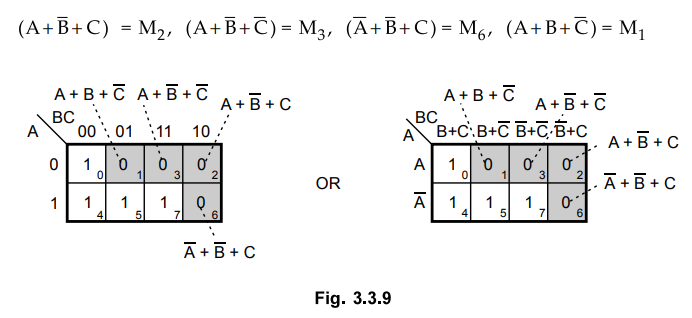
Ex
3.3.4 Plot Boolean expression.

Sol.
:
The expression has 4-variables and hence it can be plotted using 4-variable map
as shown in Fig. 3.3.10.
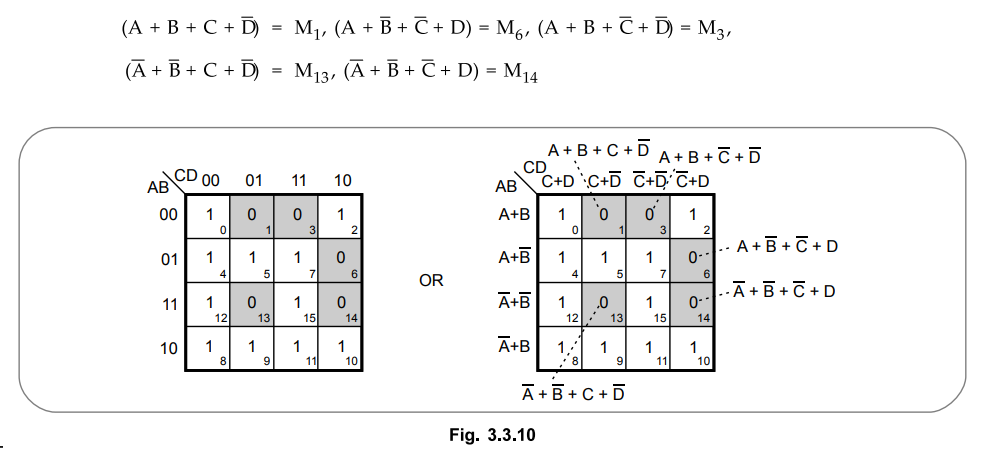
3. Grouping Cells for Simplification
•
In the last section we have seen representation of Boolean function on the
Karnaugh map. We have also seen that minterms are marked by Is and maxterms are
marked by Os. Once the Boolean function is plotted on the Karnaugh map we have
to use grouping technique to simplify the Boolean function. The grouping is
nothing but combining terms in adjacent cells. Two cells are said to be
adjacent if they conform the single change rule. i.e. there is only one
variable difference between co-ordinates of two cells. For example, the cells for
minterms ABC and ABC are adjacent. The Fig. 3.3.11 shows the adjacent cells.
The simplification is achieved by grouping adjacent Is or Os in groups of 21,
where i = 1, 2, ..., n and n is the number of variables. When adjacent Is are
grouped then we get result in the sum of products form; otherwise we get result
in the product of sums form. Let us see the various grouping rules.
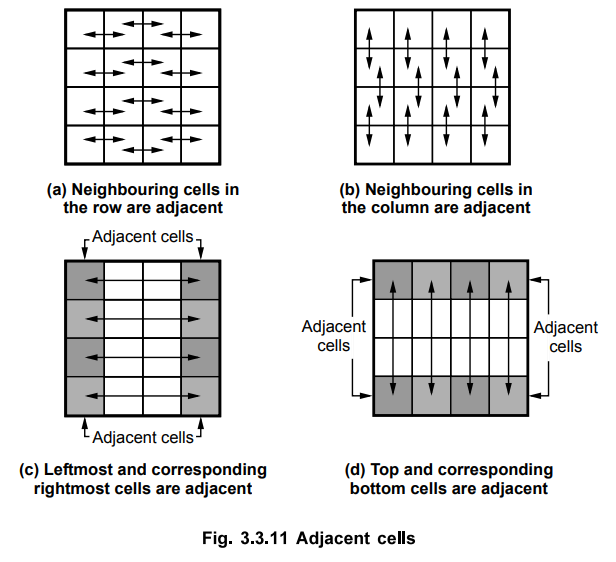
a.
Grouping Two Adjacent Ones (Pair)
•
Fig. 3.3.12 (a) shows the Karnaugh map for a particular three variable truth
table. This K-map contains a pair of Is that are horizontally adjacent to each
other; the first represents  and the second represents
and the second represents  .
Note that in these two terms only the B variable appears in both normal and complemented
form (
.
Note that in these two terms only the B variable appears in both normal and complemented
form (![]() and C remain unchanged). Thus these two terms can be combined
to give a resultant that eliminates the B variable since it appears in both
uncomplemented and complemented form. This is easily proved as follows :
and C remain unchanged). Thus these two terms can be combined
to give a resultant that eliminates the B variable since it appears in both
uncomplemented and complemented form. This is easily proved as follows :

•
This same principle holds true for any pair of vertically or horizontally
adjacent Is. Fig. 3.3.12 (b) shows an example of two vertically adjacent Is.
These two can be combined to eliminate A variable since it appears in both its
uncomplemented and complemented forms. This gives result

•
In a Karnaugh map the corresponding cells in the leftmost column and rightmost
column are considered to be adjacent. Thus, the two Is in these columns with a
common row can be combined to eliminate one variable. This is illustrated in
Fig. 3.3.12 (c).
•
Here variable B has appeared in both its complemented and uncomplemented forms
and hence eliminated as follows :
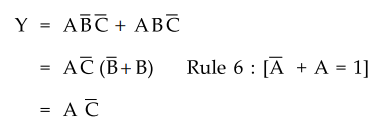
•
Let us see another example shown in Fig. 3.3.12 (d). Here two Is from top row
and bottom row of some column are combined to eliminate variable A, since in a
K-map the top row and bottom row are considered to be adjacent.

Fig.
3.3.12 (e) shows a Karnaugh map that has two overlapping pairs of Is. This shows
that we can share one term between two pairs.
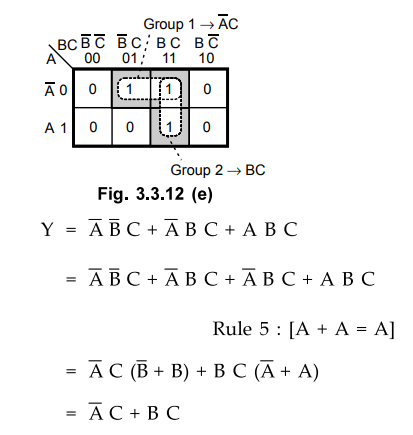
Fig.
3.3.12 (f) shows a K-map where three group of pairs can be formed. But only two
pairs are enough to include all 1s present in the K-map. In such cases third
pair is not required.
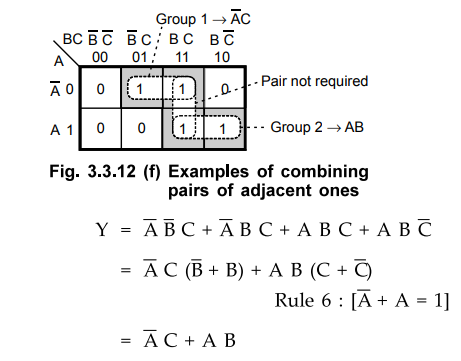
A
pair is a group of two adjacent cells in a Karnaugh map. It cancels one
variable in a K-map simplification.
b.
Grouping Four Adjacent Ones (Quad)
In
a Karnaugh map we can group four adjacent Is. The resultant group is called
Quad. Fig. 3.3.13 shows several examples of quads. Fig. 3.3.13 (a) shows the
four Is are horizontally adjacent and Fig. 3.3.13 (b) shows they are vertically
adjacent.

A
K-map in Fig. 3.3.13 (c) contains four Is in a square and they are considered
adjacent to each other. The four Is in Fig. 3.3.13 (d) are also adjacent, as
are those in Fig. 3.3.13 (e) because, as mentioned earlier, the top and bottom
rows are considered to be adjacent to each other and the leftmost and rightmost
columns are also adjacent to each other.
From
the above Karnaugh maps we can easily notice that when a quad is combined two
variables are eliminated. For example, in Fig. 3.3.13 (c) we have following
terms with 4 variables :

Fig.
3.3.13 (f) shows overlapping groups. As mentioned earlier one term can be
shared between two or more groups.

Quad
is a group of four adjacent cells in a Karnaugh map. It cancels two variables
in a K-map simplification.
c. Grouping Eight Adjacent Ones (Octet)
•
In a Karnaugh map we can group eight adjacent 1s. The resultant group is called
as octet. Fig. 3.3.14 shows several examples of octets. Fig. 3.3.14 (a) shows
the eight 1s are horizontally adjacent and Fig. 3.3.14 (b) shows they are
vertically adjacent.
From
the Fig. 3.3.14 we can easily observe that when an octet is combined in a four
variable map, three of the four variables are eliminated because only one
variable remains unchanged. For example, in K-map shown in Fig. 3.3.14 (a) we
have following terms:


Octet
is a group of eight adjacent cells in a Karnaugh map. It cancels three
variables in a K-map simplifications.
4. Illegal Grouping
•
The Fig. 3.3.15 shows the examples of illegal grouping of cells.
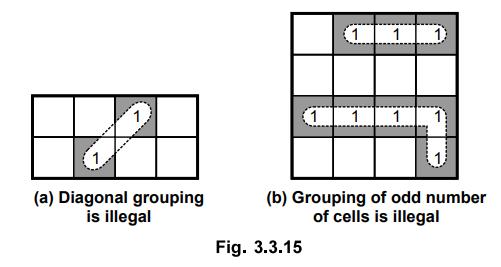
Digital Logic Circuits: Unit II: Combinational Circuits : Tag: : - Karnaugh Map (K-map) Representation and Minimization using K-maps
Related Topics
Related Subjects
Digital Logic Circuits
EE3302 3rd Semester EEE Dept | 2021 Regulation | 3rd Semester EEE Dept 2021 Regulation
